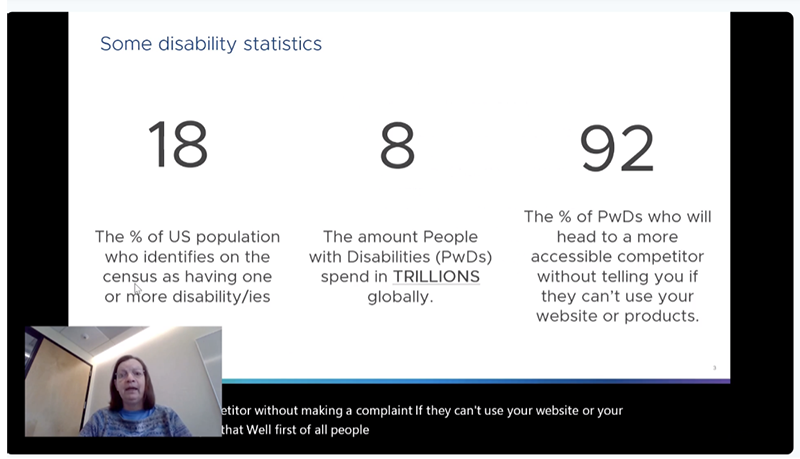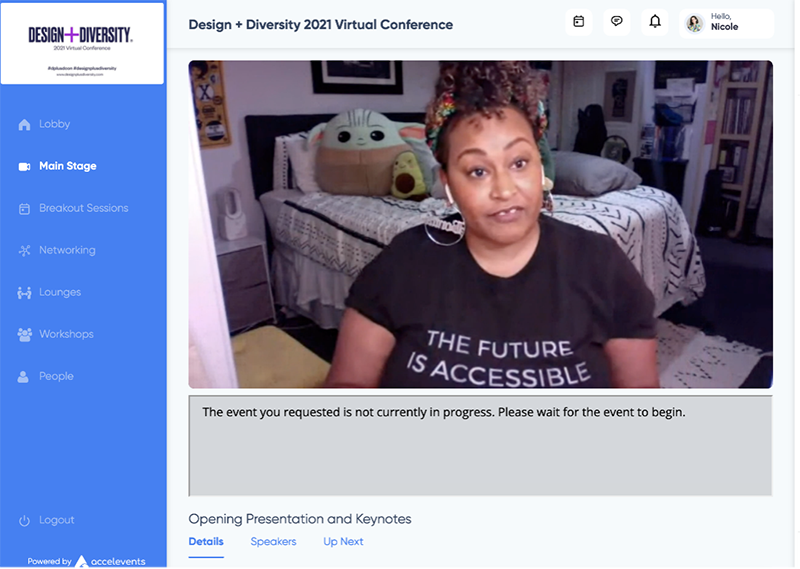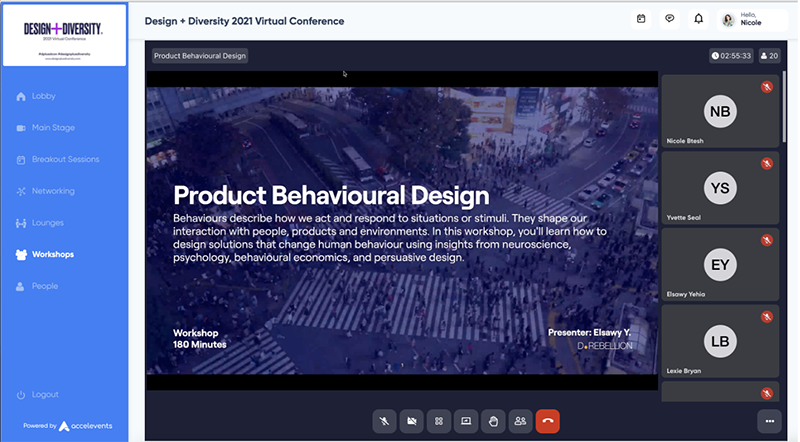Embedding inclusive design and user accessibility into our everyday ways of working starts with us designers. At ITX, we walk the talk and take our commitments seriously. So when we learned about the 2021 Design + Diversity Conference, we made a point to show up – in force.
The 3-day, virtual event featured a diverse set of speakers and attendees. Conference keynotes addressed the following topics, each fundamental to the growth and acceptance of inclusive design:
- Equity and inclusion
- Social justice and ethical design
- Accessibility and universal design concepts
- Lack of representation of women of color and minorities in design
The big theme at the conference: we’re all learning. When it comes to inclusion, no one person or organization is getting all of it right. And in order to learn, we need to listen to each other. At Design + Diversity, there was equal emphasis on developing tactics and sharing real human experience and emotion, which made for a really rich learning experience. It was awesome to spend a few days with people who are committed to design better and be better.
Here are the highlights from a handful of our favorite sessions:
Takeaway #1: How to lose a customer in only 8 seconds
In her keynote address, accessibility expert Sheri Byrne-Haber Paris spoke about integrating accessibility best practices and the importance of advocating for accessibility within your organization. Ninety-eight percent of the web is inaccessible, she shared, and people with disabilities are really constrained to 2% of the web. We were shocked but unfortunately not surprised by these statistics – reaffirming that everyone in our industry has much work to do.
Sheri told us about the eight key warning signs that will cause people with disabilities to quickly abandon your digital product for a more accessible alternative. Use of overlays such as AccessiBe, for example, is a major design no-no. We discussed in detail the criteria and practices we need to implement to open our business/service to an $8 trillion market.

Accessibility needs to be baked into the DNA of an organization, Sheri added, noting that, “accessibility is not just about the accessibility team. Everybody in the company or organization needs to participate in producing accessible products. Your communication, emails to customers, your surveys, or however you interact, those need to be accessible.”
When asked by attendees about challenges with affecting change within an organization or team, her response was that “leaders are not about titles, they are about actions.” She believes that every person can make a difference and her motto is ’make it accessible’ is always the right answer.”
This mindset resonated with us, as our design team has been leading several bottom-up initiatives around accessibility and inclusion over the past year. We know that this can have big impact.
Takeaway #2: Black Womxn Deserve Joy
Creative director Terresa Moses presented a panel of black womxn designers, guiding them through a series of questions prompted by Umbra, her art exhibit, on the topic of intersectionality. The panelists discussed social justice in design and gave insight into the personal experiences of Black womxn in the field, from education to where they are in their careers today.
One key topic was the challenges faced in an academic environment. The panel highlighted the lack of POC (People of Color) role models in design. Additionally, certain aesthetics can be questioned by educators and students alike (e.g., use of color or vibrant style).
As designers, we can be quick to discard anything that isn’t familiar or within certain popularized standards. This fixed mindset can lead dangerously to the tokenism of design rather than respecting an aesthetic that draws from a particular culture, location, or perspective.
The discussion struck a nerve with us. By delivering an intimate, eye-opening perspective on our design industry, it reinforced in us the fact that, intentionally or not, through our work we continue to exclude rather than include. We must acknowledge its existence and do our part to thoughtfully break the cycle.

Takeaway #3: Product Behavioral Design
In his workshop on “Product Behavioral Design,” Elsawy Yehia explained the foundations for growth techniques and how to apply behavioral economics and social science to design better solutions that influence the behavior of end users.
Elsawy made a point to refer to users as “humans” and highlighted the importance of ethical design. Behavioral design is not about manipulation, he offered, but about helping people to better achieve what they already care about, value, or can benefit from.
He noted, “with great power comes great responsibility,” alluding to the fact that designers play a key role in defining the environment we live in and interact with daily, and that we need to use our skills to do good in the world.

According to Elsawy, “Behavioural design focuses on how people think, how they make decisions, how they interact with the environment.”
To take an approach focused on this idea, he introduced what he’s coined as the DUDE framework. This is a design-minded and “democratized” alternate to existing behavioral design frameworks. It entails four simple steps:
1). D – Define desired behaviours
2). U – Understand psychological barriers
3). D – Design behavioral interventions
4). E – Experiment to measure impact
As a group, we found it interesting to learn about a modified framework that was created by a designer, for designers. Elsawy’s approach underscores the importance of human-centered, outcome-driven approaches in design.
The emphasis on classic cognitive biases in his framework is key. It’s easy to become enamored with the latest shiny new object in our industry, but we could benefit from going back to the tried-and-true basics.
Takeaway #4: Envisioning A World Without Supremacy Culture
In their workshop, Lennie Gray Mowris of Lenspeace, defines principles of a supremacy mindset so that we may recognize them in our daily work and takes steps to improve. They explained how a supremacy mindset has been woven into business modeling, economics, resource management, and organizational leadership, and how it continues to perpetuate supremacy culture.
Obvious examples of supremacy culture include:
- White people appropriating other cultures and being accepted or fashionable, while the people whose culture is stolen get punished or diminished
- A Google search for “wealth” returning mostly middle-aged white people, while “poverty” returns mostly young or older people of color
Lennie pointed out several less obvious ways supremacy can influence our work culture. Some include:
- Perfectionism. A perfectionist mindset holds people to an unattainable standard. It focuses on failure and inadequacy, and that these traits are “a reflection of the person who made them, and not the mistake itself.” We can combat this mindset by embracing failure.
- Worship of the written word. The importance of written language manifests in organizational culture through documentation-heavy practices, valuing writing over other skills, or the “if it’s not in a memo or e-mail it doesn’t exist” mentality. A solution to this mindset is the celebration of diverse human expression.
- Progress = bigger/more. This is the idea that we must constantly be growing and moving forward. Placing value on growth in staff, projects, and revenue leaves little space for nontangible costs like environmental or social impact. An improved mindset would equate progress to sustainability. This means assessing those non-tangible costs along with financial costs, and creating goals for how you work.
Each of these influences forces people of different cultural and social-economic backgrounds to assimilate into western, white culture. By identifying, acknowledging, and actively changing these problems in our organizations, we can create a more inclusive work environment that fosters diversity.
Some final thoughts
Design + Diversity was a great opportunity to hear from speakers with different points of view. They taught us that representation in the industry is critical and that everyone should be able to see and work with people that they can relate to; that look or live like them.
They also paved the way for achieving a culture that supports diversity at work. These same principles of inclusion should be applied to our work/design process, so that our products are more inclusive. Adopting an inclusive mindset enables teams to be more human-centered and innovative.
The conference offered a safe space to engage in open discussions on diversity, inclusion, and accessibility. Through critical thinking and participation, attendees were able to challenge their own biases and assumptions.
It’s important that as a design community we continue to foster these types of spaces and moments so that we can reflect on how far we’ve come, understand what still needs to be done, and act.
As Annie Segarra advocates, “The future is accessible.”
Learn more about designing for inclusion with the ITX ebook: Getting Started with Product Inclusion – An imperfect guide to thinking bigger and building better digital experiences.

Nicole Btesh is a User Experience designer and facilitator. She uses contextual research and co-design workshops to create better products and services, and to innovate faster. At ITX, she co-created a framework to adapt in-person workshops to an entirely virtual environment. She also helped create a Diversity and Inclusion baseline training at ITX. She is passionate about design and gender studies and hosted Spain’s first-ever Gender Design Service Jam.

Christina Halladay is a User Experience (UX) Designer with an educational background in Psychology and a passion for ‘people’ problems. She’s driven to understand how things work and how they impact the people that interact with them. At ITX, she is a Director of UX where she works with distributed cross-functional teams to build impactful, human-centered digital products. She co-founded and organized a UX conference series called ITXUX, which brings world-renowned speakers to various cities to educate and inspire the tech community. When she’s not designing digital products, she can usually be found somewhere outside with her husband, son, and two dogs, being amazed by the design of the natural world.



